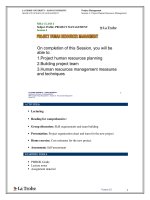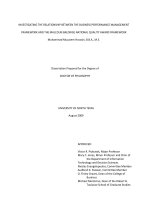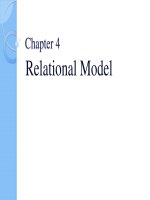Lecture Performance management: Session 4 - Osman Bin Saif
Bạn đang xem bản rút gọn của tài liệu. Xem và tải ngay bản đầy đủ của tài liệu tại đây (1.62 MB, 38 trang )
Session: Four
HRM-755
PERFORMANCE
MANAGEMENT
OSMAN BIN SAIF
1
Summary of Previous Lecture
•
Performance management Process
–
–
Components of Performance Management
process
•
Pre-requisites
•
Performance Planning
Implementation of Performance Management
process
2
Agenda of Today’s Lecture
•
Performance management Process
–
Components of PMP
•
Performance Execution
•
Performance Assessment
•
Performance review
•
Performance renewal and Re-contracting
3
Performance Execution
•
•
•
Once the review cycle begins, the employee
strives to produce the results and display the
behaviors agreed upon earlier as well as to
work on developmental needs.
The employee has primary responsibility and
ownership of this process.
Employee participation does not begins at the
performance execution stage, however
as
4
Performance Execution (Contd.)
At the performance execution stage, the
following factors must be present;
•
Commitment to goal achievement:
–
•
the employee must be committed to the goals
that were set.
Ongoing performance feedback and
coaching:
–
the employee should not wait until5the review
Performance Execution (Contd.)
•
•
Communication with supervisor:
–
supervisors are busy with multiple obligations.
–
The burden is on the employee to
communicate openly and regularly with the
supervisor.
Collecting and sharing performance data:
–
the employ should provide the supervisor with
regular updates on progress toward goal
achievement, in terms of both behavior and
6
results.
Performance Execution (Contd.)
•
Preparing for performance reviews:
–
the employee should not wait until the end of
review cycle approaches to prepare for the
review.
–
On the contrary, the employee should engage
in an ongoing and realistic self-appraisal, so
immediate correction action can be taken if
necessary.
–
The usefulness of the self appraisal system
can be enhanced by gathering informal
7
Performance Execution (Contd.)
•
Although the employee has primary
responsibilities for performance execution,
the supervisor also needs to do his or her
share of the work.
8
Performance Execution (Contd.)
Supervisors have primary responsibility over
the following issues;
•
Observation and documentation:
–
supervisors must observe and document
performance on daily basis.
–
It is important to keep track of examples of
both good and poor performance.
9
Performance Execution (Contd.)
•
Updates:
–
•
as the organizations goals may change, it is
important to update and revise initial
objectives, standards, and key
accountabilities and competency areas.
Feedback:
–
feedback on progress towards goals and
coaching to improve performance should be
provided on a regular basis, and certainly
before the review cycle is over. 10
Performance Execution (Contd.)
•
Resources:
–
supervisor should provide employees with
resources and opportunities to participate in
developmental activities.
–
Thus they should encourage and sponsor
participation in training, classes and special
assignments.
–
Overall supervisors have a responsibility to
ensure that the employee has the necessary
supplies and funding to perform the job
11
Performance Execution (Contd.)
•
Reinforcement:
–
supervisor must let employees know that their
outstanding performance is noticed by
reinforcing effective behaviors and progress
towards goals.
–
Also supervisors should provide feedback
regarding negative performance and how to
remedy the observed problem.
–
Observation and communication are not
sufficient.
–
12
13
14
Performance Assessment
•
•
In the assessment phase, both the
employee and manager are responsible
for evaluating the extent to which
behaviors have been displayed, and
whether the desired results have been
achieved.
Although many sources can be used to
collect performance information (e.g
15
peers, subordinates), in most cases
the
Performance Assessment
(Contd.)
•
This also includes an evaluation of the
extent to which the goals stated in the
development plan have been achieved.
16
Performance Assessment
(Contd.)
•
•
It is important that both the employee and
the manager take ownership of the
assesment process.
The manager fills out her appraisal form,
and the employee should also fill out his
form.
17
Performance Assessment
(Contd.)
•
When both the employee and the
supervisor are active participants in the
evaluation process, there is a greatest
likely hood that the information will be
used productively in the future.
18
Performance Assessment
(Contd.)
•
•
Specifically, the inclusion of self-ratings
help emphasize possible discrepancies
between self views and the views that
important others(i.e., supervisor) have of
our behavior.
It is discrepancy between these two views
that is most likely to trigger development
efforts, particularly when feedback from
the supervisor is more negative 19
than are
Performance Assessment
(Contd.)
•
•
The inclusion of self appraisals is also
beneficial regarding important additional
factors.
Self appraisals can reduce and
employee’s defensiveness during an
appraisal meeting and increase
employee’s satisfaction with the
performance management system, as well
as enhance perceptions of accuracy and
fairness and therefore acceptance
20 of the
Performance Assessment
(Contd.)
•
•
•
In sum both the employee and the
supervisor must evaluate employee
performance.
Employee involvement in the process
increases employee ownership and
commitment to the system.
In addition it provides important
information to be discussed during the
performance review.
21
Performance review
•
•
The performance review stage involves
meeting between the employee and the
manager to review their assessments.
This meeting is usually called the
appraisal meeting or discussions.
22
Performance review (Contd.)
•
•
The appraisal meeting is important
because it provides a formal setting in
which the employee receives feedback on
his or her performance.
In spite of its importance in performance
management ,the appraisal meeting is
often regarded as the “Achilles” heel of the
entire process.
23
Performance review (Contd.)
•
•
This is because many, managers are
uncomfortable providing performance
feedback, particularly when performance
is deficient.
This high level of discomfort, which often
translates into anxiety and the avoidance
of the appraisal interview, can be mitigated
through training those responsible for
24
providing feedback.
Performance review (Contd.)
•
•
In most cases, the appraisal meeting is
regarded as a review of the past, that is,
–
what was done(i.e results)
–
and how it was done(i.e behaviours).
The appraisal meeting also include a
discussion of the employees
developmental progress as well as plans
for the future.
25









